An unofficial blog about the National Museum of Health and Medicine (nee the Army Medical Museum) in Silver Spring, MD. Visit for news about the museum, new projects, musing on the history of medicine and neat pictures.
Thursday, January 15, 2009
A simple checklist
The Washington Post reports on an article published in today's New England Journal of Medicine that says verbal checklists used before, during, and after surgery can cut death rates “by nearly half, to 0.8 percent from 1.5 percent, and other complications falling to 7 percent from 11 percent.” This reminded me of an article we read a while ago about how a checklist used at Johns Hopkins for patients with I.V. lines dramatically cut infection rates. Of course there are those who are skeptical of the recent study with all the “yeah, but” comments, but what does it cost, how much effort does it take, and where is the harm in running through a checklist? If it was me under the knife, my choice would be to checklist away.
Tuesday, January 13, 2009
Emu editing complete; WRAMC book editing not quite
Kathleen and I got through editing the archives data for our new online Emu database today. At some point in 2009, all five collection divisions should be included and anyone will be able to search our data. We've been striving for this for years now.
Tomorrow, we'll be back to working on a photo history of Walter Reed Army Medical Center. The book, which will be from the Borden Institute, will cover 100 years of the campus in photographs. More information to come in the future.
And we'll be writing the Archives annual report this week too. You'll see it here when we finish it.
Tomorrow, we'll be back to working on a photo history of Walter Reed Army Medical Center. The book, which will be from the Borden Institute, will cover 100 years of the campus in photographs. More information to come in the future.
And we'll be writing the Archives annual report this week too. You'll see it here when we finish it.
Monday, January 12, 2009
Technology changing healthcare articles
One on the problems of epidemiology in the cell phone age - "Cellphones' Growth Does a Number on Health Research," By David Brown, Washington Post Staff Writer, Monday, January 12, 2009; Page A04.
And one on rethinking care in the ICU - "A Tactic to Cut I.C.U. Trauma: Get Patients Up," By GINA KOLATA, New York Times January 12, 2009. Doctors are experimenting with radical solutions to ward off the effects of prolonged stays in intensive care units. This article talks about several debilitating effects including that of sedation, which I can believe. Recent dental anesthesia, which was really very mild, really messed with my mind.
And one on rethinking care in the ICU - "A Tactic to Cut I.C.U. Trauma: Get Patients Up," By GINA KOLATA, New York Times January 12, 2009. Doctors are experimenting with radical solutions to ward off the effects of prolonged stays in intensive care units. This article talks about several debilitating effects including that of sedation, which I can believe. Recent dental anesthesia, which was really very mild, really messed with my mind.
A Day in the Life
Wow, what a day.
First thing this morning I finished scanning hi-res versions of flu images from the 1918 and 1957 outbreaks for a request from someone at the UN. This is a big time of year for flu photo requests. We have a folder called “Flu” that held a mix of tiffs and jpegs but not all jpegs had corresponding tiffs; hence the scanning. I burned 5 copies of the disc so the next time we won’t be scrambling to put one together (seems like something we should have done long ago, but noooo), and then FedExed the patron’s copy.
When Mike came in he and I went over what documentation is still needed for images that are being used in the 100th anniversary of Walter Reed book, and what images are needed in higher resolution. I had to use a tiny laptop computer that’s not on the network to access our external drives, where 99% of our images are, in order to look for that information. As we’ve mentioned before, the USB drives on our networked computers no longer function, so we have to go through these gyrations to get work done. Even if our external drives could still be used on the networked computers, we’re blocked from file-sharing sites, a great service I’ve used in the past to upload images. So once I finish looking those things up I’ll have to burn whatever I come up with to a disc to give to the guy doing the layout.
The Anatomical Collections manager came into the archives with a folder of negatives of the first documented military aircraft fatality, in 1908. He wanted to scan them and doesn’t have a working scanner, so we got him going on an ancient scanner and computer. I’ll get some of those images posted here, but not today.
Andrea came into the archives to measure artifacts that will be used in the Lincoln exhibit going up next month. She needs the measurements to plan the exhibit case layouts.
The museum director said there is a book in the works about the AFIP. We will likely be called on to find photos and documents for the person putting it together.
I emailed one of the archivists at Catholic University in DC to let her know that we wouldn’t be bringing them some clippings we promised them until the week after the inauguration. If you don’t live in this area, you wouldn’t believe how packed the roads are predicted to be; that is, those roads that are being allowed to stay open. I think my commute through town, and Mike’s similar commute, will be all the inauguration traffic we’ll be able to take. Come to think of it, we live here and can’t believe what’s happening to the roads, like a ban on “personal vehicles from all Potomac River bridge crossings from Virginia into the District and from interstates 395 and 66 inside the Capital Beltway on Inauguration Day.” Off-topic, but this is our life.
Mike returned from a meeting with a request from someone in the AFIP’s legal office who wanted information on the history of AFIP, so I headed to a different part of the building to pull files for her. On the way I met Andrea who asked for a scan of an oversized image of Ford’s Theater. My large-format scanner hasn’t arrived yet so I’ll either have to take it to another office where there is one, or scan it at my desk and stitch it together in Photoshop, which I’m not at all good at. That request is still percolating.
After lunch Mike and I started another run-through of the data that’s been uploaded into this new relational database the museum is converting to. We both really, really, really hate this job. We work from a print-out that’s organized by collection, and then by field, to check that the data has mapped from our old database into the correct fields in the new one. This process has been done probably 6 times and the notes for each run-through are in a different color. We’re running out of pen colors. Today one of the modules kept freezing. Grrr. We did that as long as we could stand it.
Jim from Historical Collections came in trying to match an image of an artificial kidney to the one we have on display, for a researcher request he’s gotten. We pulled the original picture to take to the exhibit floor to make the comparison. It’s not the same machine. Very similar but not quite. Here's a photo, different from what Jim was looking at, to show you this machine.
NCP 4068 MARYLAND EXHIBIT AND DEMONSTRATION OF U.S. ARMY EQUIPMENT AT ABERDEEN PROVING GROUND. MAJ. M.E. MCDOWELL AND LT. COL. FRANK L. BAUER EXPLAIN THE OPERATION OF THE ARTIFICIAL KIDNEY AT THE ARMY MEDICAL SERVICE EXHIBIT. 4 MARCH 1953

First thing this morning I finished scanning hi-res versions of flu images from the 1918 and 1957 outbreaks for a request from someone at the UN. This is a big time of year for flu photo requests. We have a folder called “Flu” that held a mix of tiffs and jpegs but not all jpegs had corresponding tiffs; hence the scanning. I burned 5 copies of the disc so the next time we won’t be scrambling to put one together (seems like something we should have done long ago, but noooo), and then FedExed the patron’s copy.
When Mike came in he and I went over what documentation is still needed for images that are being used in the 100th anniversary of Walter Reed book, and what images are needed in higher resolution. I had to use a tiny laptop computer that’s not on the network to access our external drives, where 99% of our images are, in order to look for that information. As we’ve mentioned before, the USB drives on our networked computers no longer function, so we have to go through these gyrations to get work done. Even if our external drives could still be used on the networked computers, we’re blocked from file-sharing sites, a great service I’ve used in the past to upload images. So once I finish looking those things up I’ll have to burn whatever I come up with to a disc to give to the guy doing the layout.
The Anatomical Collections manager came into the archives with a folder of negatives of the first documented military aircraft fatality, in 1908. He wanted to scan them and doesn’t have a working scanner, so we got him going on an ancient scanner and computer. I’ll get some of those images posted here, but not today.
Andrea came into the archives to measure artifacts that will be used in the Lincoln exhibit going up next month. She needs the measurements to plan the exhibit case layouts.
The museum director said there is a book in the works about the AFIP. We will likely be called on to find photos and documents for the person putting it together.
I emailed one of the archivists at Catholic University in DC to let her know that we wouldn’t be bringing them some clippings we promised them until the week after the inauguration. If you don’t live in this area, you wouldn’t believe how packed the roads are predicted to be; that is, those roads that are being allowed to stay open. I think my commute through town, and Mike’s similar commute, will be all the inauguration traffic we’ll be able to take. Come to think of it, we live here and can’t believe what’s happening to the roads, like a ban on “personal vehicles from all Potomac River bridge crossings from Virginia into the District and from interstates 395 and 66 inside the Capital Beltway on Inauguration Day.” Off-topic, but this is our life.
Mike returned from a meeting with a request from someone in the AFIP’s legal office who wanted information on the history of AFIP, so I headed to a different part of the building to pull files for her. On the way I met Andrea who asked for a scan of an oversized image of Ford’s Theater. My large-format scanner hasn’t arrived yet so I’ll either have to take it to another office where there is one, or scan it at my desk and stitch it together in Photoshop, which I’m not at all good at. That request is still percolating.
After lunch Mike and I started another run-through of the data that’s been uploaded into this new relational database the museum is converting to. We both really, really, really hate this job. We work from a print-out that’s organized by collection, and then by field, to check that the data has mapped from our old database into the correct fields in the new one. This process has been done probably 6 times and the notes for each run-through are in a different color. We’re running out of pen colors. Today one of the modules kept freezing. Grrr. We did that as long as we could stand it.
Jim from Historical Collections came in trying to match an image of an artificial kidney to the one we have on display, for a researcher request he’s gotten. We pulled the original picture to take to the exhibit floor to make the comparison. It’s not the same machine. Very similar but not quite. Here's a photo, different from what Jim was looking at, to show you this machine.
NCP 4068 MARYLAND EXHIBIT AND DEMONSTRATION OF U.S. ARMY EQUIPMENT AT ABERDEEN PROVING GROUND. MAJ. M.E. MCDOWELL AND LT. COL. FRANK L. BAUER EXPLAIN THE OPERATION OF THE ARTIFICIAL KIDNEY AT THE ARMY MEDICAL SERVICE EXHIBIT. 4 MARCH 1953

Sunday, January 11, 2009
User-correcting eyeglasses and your own personal genome
A couple of interesting medical technology pieces from the newspapers:
My Genome, My Self
By STEVEN PINKER
New York Times Magazine January 11, 2009
In the coming era of consumer genetics, your DNA will have much to tell you about the biological bases of your health, your physique and even your personality. But will this knowledge really amount to self-knowledge?
From a Visionary English Physicist, Self-Adjusting Lenses for the Poor
By Mary Jordan
Washington Post Foreign Service
Saturday, January 10, 2009; Page A08
Joshua Silver models a pair of the self-adjusting glasses he developed for the poor. The glasses work on the principle that the more liquid pumped into a thin sac in the plastic lenses, the stronger the correction.
My Genome, My Self
By STEVEN PINKER
New York Times Magazine January 11, 2009
In the coming era of consumer genetics, your DNA will have much to tell you about the biological bases of your health, your physique and even your personality. But will this knowledge really amount to self-knowledge?
From a Visionary English Physicist, Self-Adjusting Lenses for the Poor
By Mary Jordan
Washington Post Foreign Service
Saturday, January 10, 2009; Page A08
Joshua Silver models a pair of the self-adjusting glasses he developed for the poor. The glasses work on the principle that the more liquid pumped into a thin sac in the plastic lenses, the stronger the correction.
Friday, January 9, 2009
Brains on our minds
One of us came across this great blog post today "100 Fascinating Facts You Never Knew About The Human Brain." Check that out. We know a few things about brains at the Museum.
Earlier today, we were oh-so-close to having the brain and spinal cord on display (part of the Blackburn collection, in the Human Body exhibit) featured on Brazilian TV. In the end, they chose a different background for the brief intro they were filming in the Museum. It's always fun (read that with a tinge of sarcasm) having film crews in for one purpose or another. But I do appreciate the brevity that news film crews bring to their work: quick, to the point, get it right the first time. The stories I could tell about documentary film crews, though...
One cool trick that the on-air reporter employed today: he recorded his script into a handheld digital audio recorder, then had that running into his ear via a very small earpiece, similar to an IFB system more often seen on newsroom sets. So, his delivery was umimpeded by looking down into a script, and he was able to focus on the camera. He said it was an old radio trick; I put it into the 'you learn something new each day' category.
Soldier's remains still surface at Antietam Civil War battlefield
See "Remains of Civil War soldier found at Antietam," By David Dishneau, Associated Press, January 8, 2009. Doug Owsley of the Smithsonian is consulting in the case.
Museum alum begins blogging
Jenn Heilman, formerly of our Public Affairs staff, was selected for an article on "DC's singles in Washingtonian magazine. The article will not run until August 2009, but until then, they will be chronicling my dating life in an online blog with 6 other DC daters called Dating Diaries. My "profile" went public today. Check back every week -- you'll start seeing details on my dating life next week, but remember, it's on a delay for privacy so what you read about next week actually happened a month ago! I'll also be writing some of the entries myself during "roundtables" where I weigh in with dating advice or thoughts."
Good luck, Jenn!
Good luck, Jenn!
Thursday, January 8, 2009
Gail Paster on Shakespeare at NLM
This will probably be an excellent talk, but I no longer go to the NLM due to NIH's ridiculous security measures.
NATIONAL LIBRARY OF MEDICINE,
History of Medicine Division Seminar
Wednesday, January 14, 2009, 2-3:30pm
Lister Hill Auditorium, Bldg 38A, NLM
Bethesda, MD
"The Humor of It: Bodies, Fluids, and the History of Medicine in Shakespeare."
Dr. Gail Kern Paster,
Director, The Folger Shakespeare Library
Gail Kern Paster took office as Director of the Folger Shakespeare Library in 2002. She is the author of numerous scholarly articles and three books. Her latest book, "Humoring the Body: Emotions and the Shakespearean Stage" will form the core of her talk, which will examine how humoral theory, the central tenet of Renaissance medicine, affected how characters acted and reacted on the stage and in life.
Due to advance interest in this talk, the presentation will be held in the Lister Hill Auditorium.
All are Welcome
Note: The next history of medicine seminar will be held on Wednesday, February 11, 2009 at 2-3:30pm in the Lister Hill Auditorium. In a special program for African American History Month, Professor Kevin Mumford will speak on "Brother Redeemers: Black Gay History and the Impact of the Aids Crisis, 1974-1988."
Sign language interpretation is provided. Individuals with disabilities who need reasonable accommodation to participate may contact Stephen Greenberg at (301-435-4995), e-mail greenbes@mail.nih.gov, or the Federal Relay (1-800-877-8339).
Due to current security measures at NIH, off-campus visitors are advised to consult the NLM Visitors and Security website:
http://www.nlm.nih.gov/about/visitor.html
Stephen J. Greenberg, MSLS, PhD
Coordinator of Public Services
History of Medicine Division
National Library of Medicine
National Institutes of Health
Department of Health and Human Services
301-435-4995
greenbes@mail.nih.gov
NATIONAL LIBRARY OF MEDICINE,
History of Medicine Division Seminar
Wednesday, January 14, 2009, 2-3:30pm
Lister Hill Auditorium, Bldg 38A, NLM
Bethesda, MD
"The Humor of It: Bodies, Fluids, and the History of Medicine in Shakespeare."
Dr. Gail Kern Paster,
Director, The Folger Shakespeare Library
Gail Kern Paster took office as Director of the Folger Shakespeare Library in 2002. She is the author of numerous scholarly articles and three books. Her latest book, "Humoring the Body: Emotions and the Shakespearean Stage" will form the core of her talk, which will examine how humoral theory, the central tenet of Renaissance medicine, affected how characters acted and reacted on the stage and in life.
Due to advance interest in this talk, the presentation will be held in the Lister Hill Auditorium.
All are Welcome
Note: The next history of medicine seminar will be held on Wednesday, February 11, 2009 at 2-3:30pm in the Lister Hill Auditorium. In a special program for African American History Month, Professor Kevin Mumford will speak on "Brother Redeemers: Black Gay History and the Impact of the Aids Crisis, 1974-1988."
Sign language interpretation is provided. Individuals with disabilities who need reasonable accommodation to participate may contact Stephen Greenberg at (301-435-4995), e-mail greenbes@mail.nih.gov, or the Federal Relay (1-800-877-8339).
Due to current security measures at NIH, off-campus visitors are advised to consult the NLM Visitors and Security website:
http://www.nlm.nih.gov/about/visitor.html
Stephen J. Greenberg, MSLS, PhD
Coordinator of Public Services
History of Medicine Division
National Library of Medicine
National Institutes of Health
Department of Health and Human Services
301-435-4995
greenbes@mail.nih.gov
AUGUST 2009 NATIONAL HUMAN CADAVER PROSECTION PROGRAM
Anatomical collections manager Brian Spatola asked me to post this; he attended last year and thought it was good.
AUGUST 2009 NATIONAL HUMAN CADAVER PROSECTION PROGRAM
****** 10th ANNUAL SESSION ******
All interested parties are invited to apply for the
AUGUST 2009 NATIONAL HUMAN CADAVER PROSECTION PROGRAM
August 5 - 6
at the Indiana University School of Medicine - Northwest
Dunes Medical Professional Building
3400 Broadway
Gary, Indiana
APPLICATION DEADLINE: *** MAY 1, 2009 ***
PROGRAM SPONSORS: Rocco Prosthetics & Orthotic Center (Cincinnati, OH) and MORTECH Manufacturing (Azusa, CA).
Applications for the August 2009 NATIONAL Human Cadaver Prosection Program are now being accepted. All participants will learn human gross anatomy, radiology/medical imaging, and the art of skillful dissection of human cadavers. The CADAVER PROGRAM is an intensive experience of "hands-on" dissection. Participants who complete the
program will receive a certificate of completion, certification for work with biohazards & blood-borne pathogens, and honorarium (if available). SPECIAL Awards will be presented.
Representatives from Zimmer, Inc. (Zimmer Orthopedics) will conduct an on-site surgical, orthopedic workshop, and Rocco Prosthetics will present a special prosthetic session. [CME Credit is offered].
The Cadaver Prosection will be held on Wednesday, August 5 and Thursday, August 6, 2009, from 7:45 a.m. - 5:00 p.m., and will include 2 evenings of preparatory work in late June (out-of-state participants need not be present for the June sessions).
NEW for 2009, will be hands-on, interactive CT and MR imaging of human cadavers (for 10-12 selected participants) to take place in mid-July.
TO APPLY for this program, place the web address (below) into your browser, and then scroll down and click on the AUGUST 2009 NATIONAL HUMAN CADAVER PROSECTION PROGRAM link.
http://medicine.iu.edu/body.cfm?id=4951&oTopID=225
Please, follow the application instructions.
You need not be a medical professional or pre-medical student to participate. All are encouraged to apply. Prior participants have included pre-med and pre-vet, nursing, radiologic technology, mortuary science students, other undergraduate and graduate students, teachers, attorneys, lab technicians, etc. All application materials must be received no later than MAY 1, 2009. Accepted applicants will receive notification in early June.
For further information use the link above, or contact the program director:
Ernest F. Talarico, Jr., Ph.D.
Assistant Director of Medical Education & Assistant Professor of
Anatomy & Cell Biology
Course Director, Human Gross Anatomy & Embryology
Director, NATIONAL Human Cadaver Prosection Program
Indiana University School of Medicine - Northwest Campus
Room 3028A (office); 3028 (lab); 2032 (anatomy lab)
3400 Broadway
Gary, Indiana 46408-1197
TEL: (219) 981-4356; FAX: (219) 980-6566
Email: cadaver@iun.edu (Prosection Program); etalaric@iun.edu (IUSM-NW)
AUGUST 2009 NATIONAL HUMAN CADAVER PROSECTION PROGRAM
****** 10th ANNUAL SESSION ******
All interested parties are invited to apply for the
AUGUST 2009 NATIONAL HUMAN CADAVER PROSECTION PROGRAM
August 5 - 6
at the Indiana University School of Medicine - Northwest
Dunes Medical Professional Building
3400 Broadway
Gary, Indiana
APPLICATION DEADLINE: *** MAY 1, 2009 ***
PROGRAM SPONSORS: Rocco Prosthetics & Orthotic Center (Cincinnati, OH) and MORTECH Manufacturing (Azusa, CA).
Applications for the August 2009 NATIONAL Human Cadaver Prosection Program are now being accepted. All participants will learn human gross anatomy, radiology/medical imaging, and the art of skillful dissection of human cadavers. The CADAVER PROGRAM is an intensive experience of "hands-on" dissection. Participants who complete the
program will receive a certificate of completion, certification for work with biohazards & blood-borne pathogens, and honorarium (if available). SPECIAL Awards will be presented.
Representatives from Zimmer, Inc. (Zimmer Orthopedics) will conduct an on-site surgical, orthopedic workshop, and Rocco Prosthetics will present a special prosthetic session. [CME Credit is offered].
The Cadaver Prosection will be held on Wednesday, August 5 and Thursday, August 6, 2009, from 7:45 a.m. - 5:00 p.m., and will include 2 evenings of preparatory work in late June (out-of-state participants need not be present for the June sessions).
NEW for 2009, will be hands-on, interactive CT and MR imaging of human cadavers (for 10-12 selected participants) to take place in mid-July.
TO APPLY for this program, place the web address (below) into your browser, and then scroll down and click on the AUGUST 2009 NATIONAL HUMAN CADAVER PROSECTION PROGRAM link.
http://medicine.iu.edu/body.cfm?id=4951&oTopID=225
Please, follow the application instructions.
You need not be a medical professional or pre-medical student to participate. All are encouraged to apply. Prior participants have included pre-med and pre-vet, nursing, radiologic technology, mortuary science students, other undergraduate and graduate students, teachers, attorneys, lab technicians, etc. All application materials must be received no later than MAY 1, 2009. Accepted applicants will receive notification in early June.
For further information use the link above, or contact the program director:
Ernest F. Talarico, Jr., Ph.D.
Assistant Director of Medical Education & Assistant Professor of
Anatomy & Cell Biology
Course Director, Human Gross Anatomy & Embryology
Director, NATIONAL Human Cadaver Prosection Program
Indiana University School of Medicine - Northwest Campus
Room 3028A (office); 3028 (lab); 2032 (anatomy lab)
3400 Broadway
Gary, Indiana 46408-1197
TEL: (219) 981-4356; FAX: (219) 980-6566
Email: cadaver@iun.edu (Prosection Program); etalaric@iun.edu (IUSM-NW)
Abraham Lincoln Exhibit Coming up at NMHM, exhibit poster by Navjeet Singh Chhina
 I think this came out really well,
I think this came out really well, I want to thank Kathleen Stocker,
who was very generous with her
time and scanned these for me
as well as photographed
the litho of Lincoln.
Thanks also to Mike Rhode,
for his time as well. Because
content is so important, and
the right content is all important
they made it very easy for me
to just do my job and design.
I did this in Photoshop
and Indesign. What I think
museum visitors will find interesting
is that with the exception of the Harpers
drawing, all of the other components in
this exhibit poster came from actual
artifacts in the Otis Archives from NMHM. Including the very rare
signature of Lincoln, which includes his full first name instead of the
A. Lincoln signature.
Labels:
Abraham Lincoln,
exhibits,
Navjeet Singh Chhina
Wednesday, January 7, 2009
A few more from Ball
I didn't have time to even open a box from the Ball Collection today, so these are left over from yesterday. They're all from “Miniatur-Abbildungen der wichtigsten Akiurgischen Operationen,” a book illustrating Dieffenbach's operations, by Dr. H. E. Fritze. (1838) The descriptions are transcribed and I don't have a translation. It's a fairly delicate book, which is why you can see shadows at the gutter.
Table 1: venaescetio (obviously not ophthalmic, but I liked it anyway)

Table 5: Suturae cruentae; Staphyloraphe; Operatio labii leporini

Table 10: Paracentesis sacci lacrymalis oper. Catar. Et trichiasis; Operatio blepharoptosis et pterygii

Table 1: venaescetio (obviously not ophthalmic, but I liked it anyway)

Table 5: Suturae cruentae; Staphyloraphe; Operatio labii leporini

Table 10: Paracentesis sacci lacrymalis oper. Catar. Et trichiasis; Operatio blepharoptosis et pterygii

Labels:
Ball Collection,
medical illustration,
ophthalmology
Cochlear implants evolving
The Washington Post had an interesting article on cochlear implants - "One Implant Made an Impact. Might Two Do Even More? For Family, Second Cochlear Surgery Was a Difficult Decision," By Anne Dooley, Special to The Washington Post, Tuesday, January 6, 2009; Page HE05. The article discussed how the use of the implants and the number used is changing (from one to two for various reasons) after the requisite fights with insurance companies.
If anyone has one of these to donate to the museum, even non-working, please let us know.
If anyone has one of these to donate to the museum, even non-working, please let us know.
Tuesday, January 6, 2009
Wellcome War & Medicine exhibit open through February
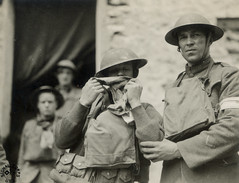 War and Medicine (22 November 2008-15 February 2009) is on display in London. I imagine this is a good exhibit. Be sure to check out the image galleries which in particular have a couple of nice shell shock images. You can see this one of ours on our flickr site as well as some mustard gas images. We recently put some facial reconstruction models on display very similar to the one seen in the photos on the Wellcome site, except ours are colored.
War and Medicine (22 November 2008-15 February 2009) is on display in London. I imagine this is a good exhibit. Be sure to check out the image galleries which in particular have a couple of nice shell shock images. You can see this one of ours on our flickr site as well as some mustard gas images. We recently put some facial reconstruction models on display very similar to the one seen in the photos on the Wellcome site, except ours are colored.
Monday, January 5, 2009
Jan 7: Museum exhibit manager Steve Hill speaking on Resolved exhibit design
This is one of AFIP's professional education lectures, but I imagine if one wanted to attend, one could.
The following lecture is presented by the National Museum of Health and Medicine
Date/Time: 07 Jan 09/1100am
Location: Dart Auditorium
Speaker(s): Steven Hill
Exhibits Manager
National Museum of Health and Medicine
Title:
“RESOLVED: Turning a good idea, clinical expertise, and field experience into a museum exhibit”
Objectives:
To explain how a scientific/health museum exhibit is created from the ground up
Description:
Talk will cover all aspects of turning an idea—in this case the United States’ commitment to individual identification of its war dead—into an museum exhibit. Subtopics will include differences between museum exhibit and other forms of communication/education, how concepts are refined and broken down into topics that can be visually presented in a museum setting, selection and security of artifacts, exhibit design and visitor flow, construction and installation.
The following lecture is presented by the National Museum of Health and Medicine
Date/Time: 07 Jan 09/1100am
Location: Dart Auditorium
Speaker(s): Steven Hill
Exhibits Manager
National Museum of Health and Medicine
Title:
“RESOLVED: Turning a good idea, clinical expertise, and field experience into a museum exhibit”
Objectives:
To explain how a scientific/health museum exhibit is created from the ground up
Description:
Talk will cover all aspects of turning an idea—in this case the United States’ commitment to individual identification of its war dead—into an museum exhibit. Subtopics will include differences between museum exhibit and other forms of communication/education, how concepts are refined and broken down into topics that can be visually presented in a museum setting, selection and security of artifacts, exhibit design and visitor flow, construction and installation.
More from the Ball Collection
Here are a few more scans from the Ball Collection. For as long as we've had it, we've thought the name was James Moore Ball. Today we discovered his middle name is Moores, with an s on the end. Just tuck that trivia away. You might need it one day.
Acc. 18873 Morbi Conjunctiva palpebrarum et bulbi. Diseases of the ocular and palpebral conjunctiva. Colored plate I from Dr. Friedrich August von Ammon's book (vol. 1).

Acc. 18874 Diseases of the bulbar and palpebral conjunctiva. Colored plate II from Dr. von Ammon's book (vol. 1).

Acc. 18875 Diseases of the cornea. Colored plate III from Dr. von Ammon's book (vol. 1).

Acc. 18873 Morbi Conjunctiva palpebrarum et bulbi. Diseases of the ocular and palpebral conjunctiva. Colored plate I from Dr. Friedrich August von Ammon's book (vol. 1).

Acc. 18874 Diseases of the bulbar and palpebral conjunctiva. Colored plate II from Dr. von Ammon's book (vol. 1).

Acc. 18875 Diseases of the cornea. Colored plate III from Dr. von Ammon's book (vol. 1).

Sunday, January 4, 2009
Less pharmaceutical advertising fun
No Mug? Drug Makers Cut Out Goodies for Doctors
By NATASHA SINGER
New York Times December 31, 2008
The pharmaceutical industry has agreed to a voluntary moratorium on branded promotional items.
Well, darn. I like the geegaws, although I'm in a constant debate with historical collections over whether or not to keep them. I'm in favor since they are part of medical history of a type.
By NATASHA SINGER
New York Times December 31, 2008
The pharmaceutical industry has agreed to a voluntary moratorium on branded promotional items.
Well, darn. I like the geegaws, although I'm in a constant debate with historical collections over whether or not to keep them. I'm in favor since they are part of medical history of a type.
Friday, January 2, 2009
Photographs of Museum specimens on French blog
Morbid Anatomy tipped me to E-l-i-s-e's blog post on photographs of specimens taken at the Museum. It looks like some of these were shot behind-the-scenes as even I don't recognize some of the specimens (not that it's my department...)
Thursday, January 1, 2009
Whatever Happened to Polio? exhibit photos
When the Smithsonian's National Museum of American History closed in 2006, one of the things that went with it was Katherine Ott's excellent exhibit "Whatever Happened to Polio?" I don't know if the exhibit is in the re-opened museum, but when I ran across my pictures I figured I'd share them here.
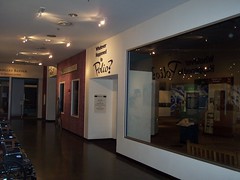

Would a vaccine work? panels
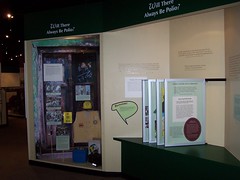
Will there always be polio? panels

What do these devices do? panel with crutches.

What is polio? panels
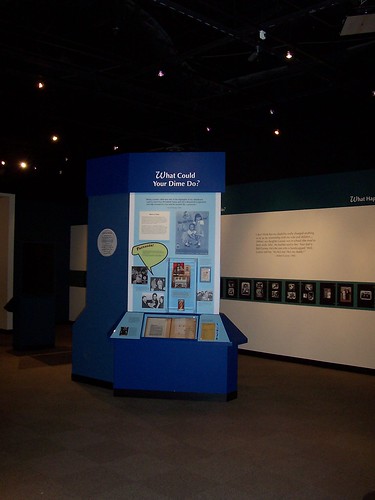
What could your dime do? (for the March of Dimes) panel
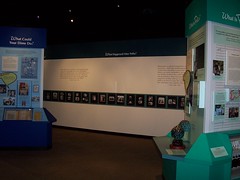

How did polio change us? panels
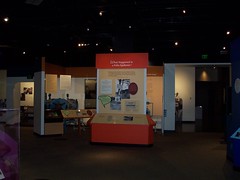
What happened in a polio epidemic? panel

Interactive station

Iron lung.
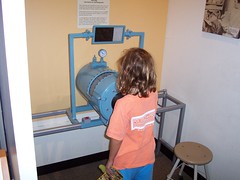
Model showing how iron lung reduced pressure to enable lungs to fill with air.
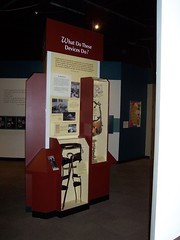
What do these devices do? panel with braces.
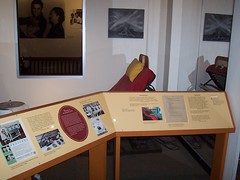



Would a vaccine work? panels

Will there always be polio? panels

What do these devices do? panel with crutches.

What is polio? panels

What could your dime do? (for the March of Dimes) panel


How did polio change us? panels

What happened in a polio epidemic? panel

Interactive station

Iron lung.

Model showing how iron lung reduced pressure to enable lungs to fill with air.

What do these devices do? panel with braces.


Staying Alive: A Look at the Medical Field in Putnam County
Visiting my inlaws over the holidays, I stumbled upon this nice little exhibit in Cookeville, Tennessee at the Cookeville History Museum on the medical history of the county. There's some stuff I haven't seen before in it, like the X-ray viewer, and some good archival records too. "Staying Alive: A Look at the Medical Field in Putnam County" is on through January 17 2009.
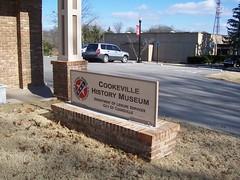
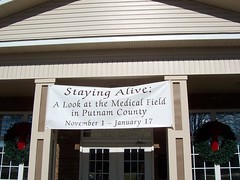
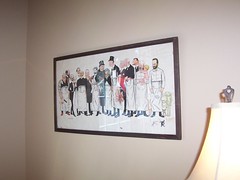
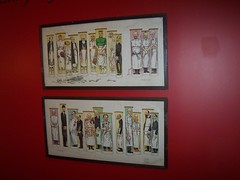
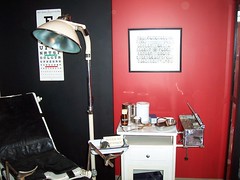

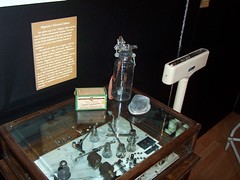
Physician's electrical cabinet
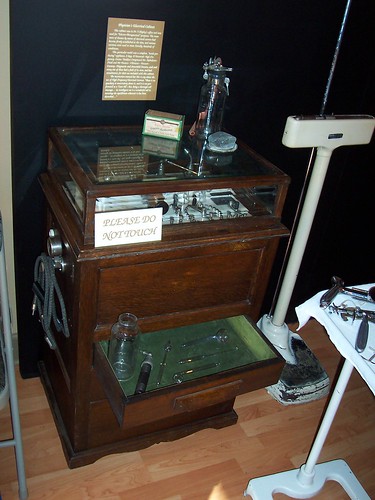



Diagnostic instruments, bandages, splints.

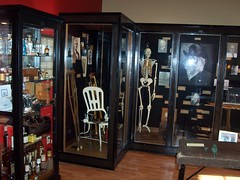
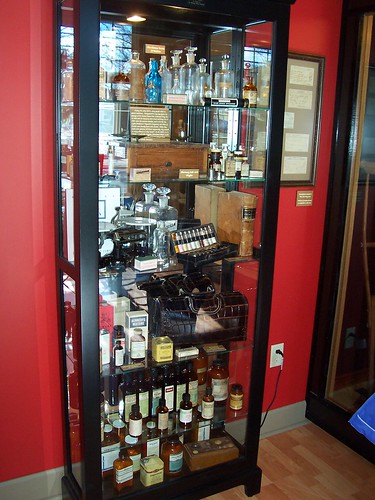
Drugs and pharmaceuticals.

X-ray equipment.
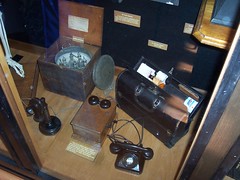
Note the sterilizer iin the corner.

Examination chair.
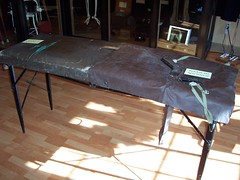
Birthing table.

Atropine for nerve gas from Vietnam War.
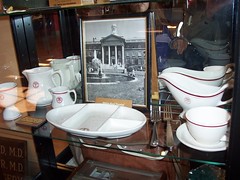
Walter Reed's dinnerware.
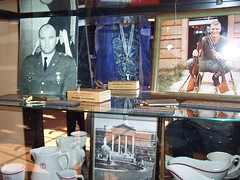
Doctors in Vietnam War.
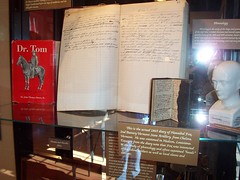



Wheelchair from a doctor's office.







Physician's electrical cabinet




Diagnostic instruments, bandages, splints.



Drugs and pharmaceuticals.

X-ray equipment.

Note the sterilizer iin the corner.

Examination chair.

Birthing table.

Atropine for nerve gas from Vietnam War.

Walter Reed's dinnerware.

Doctors in Vietnam War.




Wheelchair from a doctor's office.
Subscribe to:
Posts (Atom)